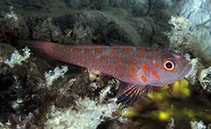
|
Trimma annosum Winterbottom, 2003 Grey-bearded pygmygoby |

|
|
photo by
Hazes, B. |
| Family: | Gobiidae (Gobies), subfamily: Gobiinae | |||
| Max. size: | 2.8 cm SL (male/unsexed) | |||
| Environment: | reef-associated; marine; depth range 1 - 60 m | |||
| Distribution: | Indo-West Pacific: Maldives and India to Papua New Guinea. | |||
| Diagnosis: | Dorsal spines (total): 7-7; Dorsal soft rays (total): 8-8; Anal spines: 1-1; Anal soft rays: 8-8. This species is distinguished by the following characters: a shallow concave bony interorbital about half pupil-diameter in width; predorsal is completely covered with ctenoid scales, no naked patches, a large scale above and between the end of the eyes above the posterior half of the pupil; cheek no scales; operculum often with a single large ctenoid scale dorsally, often followed by a smaller cycloid scale posteriorly; pectoral-fin base with 3 large vertically elongate cycloid scales; prepelvic area has 4-5 rows of cycloid scales, 1 enlarged scale between the bases of the pelvic spines; pectoral rays normally unbranched, rarely with up to 4 rays with a single branch; fifth pelvic-fin ray branched once dichotomously, rarely branched twice resulting in 3 terminal tips, 40-65% the length of the fourth; no trough or groove posterodorsal to the eye; second and third dorsal spines subequal in length, not elongated; colour of head bluish grey, cheek uniform in colour, in life a yellowish orange spot about the size of the pupil on the middle of the anterior part of the operculum, a similar sized spot dorsally and posteriorly on the operculum, a smaller yellowish orange spot behind eye; central on the pectoral base is an oval yellowish orange to reddish orange spot; body with moderate sized yellowish orange spots in 4 rows anteriorly converging to 3 on the caudal peduncle; body is fully scaled; without nape crest; dorsal and anal rays usually I,8 (Ref. 100726). | |||
| Biology: | Inhabits reef caves and crevices in 1-14 m (Ref. 90102). | |||
| IUCN Red List Status: | Least Concern (LC); Date assessed: 10 March 2015 Ref. (130435) | |||
| Threat to humans: | harmless | |||